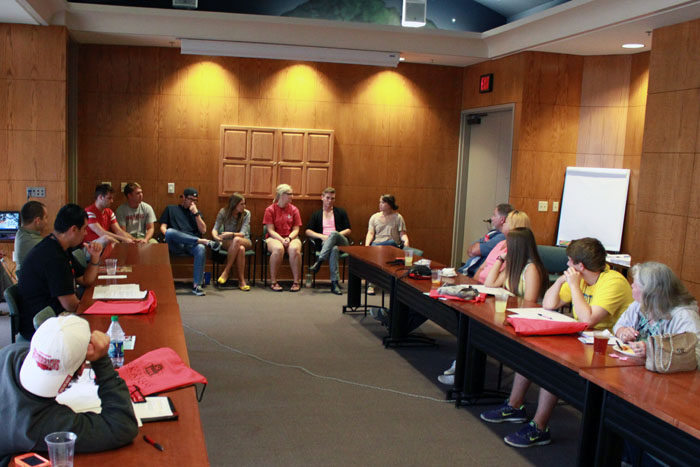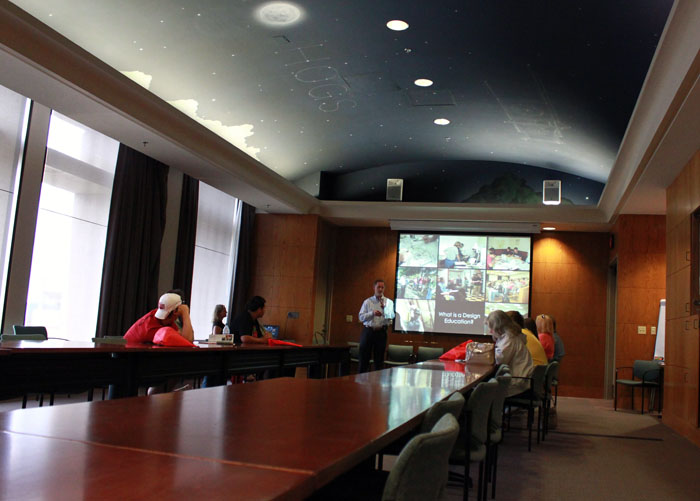
Current Fay Jones School students, from left, Andrew Schalk, Grant Gilliard, Shane Maloney, Laura Cochran, Shaelyn Vinson, Isaac Boroughs and Mary Nell Patterson offer their advice to incoming freshmen during an orientation session in June.
By Emily Lo
The last summer orientation sessions for the Fay Jones School wrapped up this week, closing out 18 sessions conducted by the school’s advising center since May.
Freshmen students and their parents were eager to hear about what university life would be like. A panel of students from the school offered some unique advice rooted in their own trials, successes and overall experiences. This summer’s student panelists included Andrew Schalk, Grant Gilliard, Shane Maloney, Laura Cochran and Shaelyn Vinson, all architecture students, Isaac Boroughs, an interior design student, and Mary Nell Patterson, a landscape architecture student.
In some June sessions, student panelists said they realized many of the freshmen were nervous about the program and their first day of school, but they reminded them that all the other freshmen would be in the same boat.
The freshmen and their parents had a slew of questions – about computer and supplies requirements, time management, personal finances, participation in Greek life, and travel through field trips and the study abroad program.
Student panelists offered advice about the design programs specifically and college life in general. The intensity and rigor of the design programs can be a shock initially, they said. They recommended that the freshmen make studio time a priority, and the default way to spend their time. Everything else on the students’ schedules should revolve around studio classes and studio projects, they agreed.
Panelists also advised the freshmen to plan out their time each week using a planner and task lists. Instead of “hangout time” with friends being the default, as was likely the case in high school, they actually need to schedule time with friends.
There were many questions about having a job, and some student panelists said they only schedule themselves to work on the weekends, though some have shifts during the week. Planning is key, they agreed. “I would start out with fewer hours to see what you can manage,” Laura Cochran said.
As for sleep, Mary Nell Patterson said that she tries to finish her projects early and get to sleep on time because she prefers to be refreshed and alert for her presentations the next day. “There will be times when we say we can let ourselves sleep for this many hours during the week, mainly during deadline weeks,” Cochran said.
Student panelists also discussed the study abroad studio required during the fourth year for architecture and landscape architecture students. Students can choose to study in Rome in the fall or spring or in Mexico in the summer – or both.
As for participation in Greek life, many panelists said the demanding schedule of design classes make it an unpopular choice – however, it is possible. Gilliard and Cochran are fraternity and sorority members, and they said it takes finding a balance. Sometimes they’ve had to miss a Greek activity or event because they had to be in studio, but there are usually ways to work around the conflict.
Many Fay Jones School students feel that studio is similar to a fraternity or sorority because they spend so much time together, working on common goals and supporting one another. With up to 120 people in the largest studio space in Vol Walker Hall, they get to know each other well and build close relationships with each other through the years.
Instructors in the Fay Jones School assign students to both individual and group projects. Working in a group can teach students how to overcome challenges they aren’t used to, and it gives them a feel for the professional world.
Some parents asked about the critiques of student work by professors in studio. Many student panelists agreed that it is important to learn how to handle criticism. They said it is the professor’s job to question everything a student does, regarding the intent of the design and the execution of that idea. Likewise, it is the student’s job to defend everything they have designed because they should know every detail by heart.
Vinson encouraged the incoming freshmen not to take all of that criticism personally. Boroughs said he likes receiving a 10-minute critique filled with criticism rather than a quick comment. He said if the critics quickly relay their comments, it feels like they’ve given up on the student and the project. More criticism means more opportunities to improve.
Another important aspect with presentations is appropriately representing design work. A student may have gone through the entire process of creating their design, but, in the end, they must know how to visually represent and display it. Some student panelists also agreed that it is fine to start a project over because, sometimes, it makes it better. Students can learn from every experience and, sometimes, they come back realizing their design was not as good as they thought, and they find ways to make it better.
One orientation group asked the panelists about what they wanted to do after graduation, since most just have a couple of years left in the program. Some knew their interests well and had an idea of the specific field they wanted to go into, while others said they had no idea yet. “The sky is the limit,” Maloney said.
Mark Boyer, landscape architecture professor and interim associate dean, explained the academic aspects of the school to each orientation group. He agreed that it’s perfectly natural for students not to know what they want to do – and not to worry. “Find a job and figure out if you like it,” Boyer said. He said they would discover much about the disciplines in school, and learn even more with professional experiences. In the future, that will all combine to help students find what they ultimately want to do.
Parents wondered how grade point averages impacted finding a job. Student panelists said that even with the tough critiques, professors do not base a student’s grade on those. Schalk advised students not to take general education classes for granted, and to excel in those classes. For example, if a student gets A’s for most of the general education courses and receives a C in a studio class, it would not ruin the student’s GPA. “The secret is: Don’t think about grades, just work,” Schalk said.
Most panelists agreed that hard work pays off. The effort put into the design work will show, and the grade will reflect that effort. Boyer added that employers in the design field will most likely ask for portfolios of work and be less interested in GPAs.
When freshmen asked about minors and double majors, panelists suggested that they focus on their major degree requirements first and work on their minor during summer school sessions. “It’s really important to get a minor, and the professors encourage it because it is good to be a well-rounded person,” said Patterson.
Panelists also discussed the different student organizations available through the Fay Jones School. The American Institute of Architecture Students (AIAS), Interior Design Organization (IDO) and American Society of Landscape Architects (ASLA) are all registered student organizations on campus.
Many student panelists said they are proud to be part of a prestigious architecture program. They appreciate the early emphasis on hand drawing and an appreciation of design basics. They also have fallen in love with the mountainous college town.
Some students, like many of the orientation panelists, secure local summer jobs so they don’t have to leave the town that’s become their home away from home.

I enjoyed the comments from the current students. I.would have offered the same advice when l was a student there in the 1970’s.